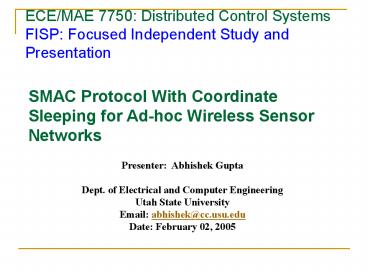SMAC protocol PowerPoint PPT Presentation
1 / 22
Title: SMAC protocol
1
ECE/MAE 7750 Distributed Control SystemsFISP
Focused Independent Study and Presentation
SMAC Protocol With Coordinate Sleeping for
Ad-hoc Wireless Sensor Networks
Presenter Abhishek Gupta Dept. of Electrical
and Computer Engineering Utah State
University Email abhishek_at_cc.usu.edu Date
February 02, 2005
2
Outline
- Introduction to Ad-hoc Wireless Sensor Networks
- The problem and existing solutions
- Introduction to S-MAC protocol
- S-MAC design
- Performance
- Conclusion
3
Introduction to Ad-hoc Wireless Sensor Networks
- An Ad Hoc wireless sensor network is a network of
sensor devices that are deployed in an ad hoc
fashion and coordinate for sensing a physical
phenomenon. - Each wireless sensing node typically includes
- A Sensor
- A processor
- A radio
- A battery
4
Ad-hoc Wireless Sensor NetworkApplications
- Applications include
- Traffic Surveillance
- Military Applications
- Fire Detection
- Agricultural management
- Structure and Earthquake monitoring
- Industrial Control
- Rescue Operations
5
Attributes of Ad hoc Wireless Sensor Networks
- Extremely power efficient
- Batteries die over time
- Cost of recharging nodes may exceed the cost of
node itself. - Insensitive to change in network topology and
node density. - New nodes can be added
- Existing nodes can be relocated
- Efficient use of bandwidth.
- Fairness can be compromised for energy
efficiency. - Inter-network data processing
- Sending raw data to some end node for processing
consume more energy.
6
Energy Efficiency in Ad hoc Wireless Sensor
Networks
- Energy efficiency is the primary concern in a
wireless sensor networks. - Causes of energy waste
- Collisions
- Takes place at the receiver
- Increases Latency
- Overhearing
- Happens when the nodes pick up data destined to
other nodes - Idle Listening
- Listening to traffic that is not sent
7
Energy Efficiency in Ad hoc Wireless Sensor
Networks
- Motes, which are used as nodes in wireless
sensor networks, work on extremely low energy
!!!
Source http//www.intel.com/research/exploratory/
motes.htm
8
MAC ProtocolsExisting Solution
- Stands for Medium Access Control.
- Determine when and how nodes should access the
shared medium. - Two broad categories
- Contention based protocols e.g. IEEE 802.11, CSMA
etc. - Scheduled based protocols e.g. TDMA, FDMA etc
9
MAC ProtocolsLimitations of Existing Solution
- TDMA (Scheduled protocol)
- Each node gets full bandwidth for a pre-allocated
time in turns - Major drawback Not suitable for networks whose
node density changes. - FDMA (Scheduled protocol)
- Each node gets a permanent share of bandwidth
- Major drawback Poor bandwidth utilization
- IEEE 802.11 (Contention based protocol)
- Each node contends for the medium as necessary
- Major drawback Wastes a lot of energy in idle
listening
10
SMAC Protocol Introduction
- Stands for Sensors Medium Access Control
- Specifically designed for Ad hoc wireless sensor
networks - Primary goal Energy Efficiency
11
SMAC designFeatures
- Main features of SMAC include
- Periodic Listen
- Collision Avoidance
- Overhearing Avoidance
- Message Passing
- Tradeoffs
12
SMAC DesignPeriodic Listen and Sleep
- Problem Idle listening consumes significant
energy - Solution Put all the nodes to sleep periodically
Turn off radio when sleeping Reduce duty cycle to
10 Preferable, neighboring nodes follow same
schedule
13
SMAC DesignChoosing and Maintaining Schedule
- Nodes exchange their schedule by periodically
broadcasting SYNC packet - Nodes take following 2 steps to choose their
schedule - Listen for SYNC packets for a fixed amount of
time - Case 1 No SYNC packets are received
- Case 2 SYNC packet is received.
- Case 3 Multiple SYNC packets are received.
Border nodes with 2 schedule broadcast twice
- Broadcast the chosen schedule by sending out
SYNC packet.
14
SMAC DesignListen and Sleep - Maintaining
Synchronization
- The listen time is divided into two parts
- For sending/receiving SYNC signal.
- For sending/receiving Data.
15
SMAC DesignAdaptive listening
- Used to reduces multi-hop latency due to periodic
sleep. - Neighboring nodes wake up for a short period of
time at the end of each transmission.
4
1
2
3
16
SMAC DesignOverhearing Avoidance
- All immediate neighbors of sender and receiver
are put to sleep upon receiving RTS/CTS. - Neighbors do not overhear data packets and
following ACKS. - The duration field in the packet indicates how
long to sleep.
17
SMAC designMessage Passing
- SMAC reintroduces the concept of Message Passing
- Long messages are converted into small fragment
and are transmitted in bursts. - Receiver acknowledges each received fragment.
Hidden terminal problem solved by ACK
C
SYNC
A
B
corrupt
18
SMAC DesignImplementation
- To demonstrate the effectiveness of SMAC protocol
compared to conventional protocols, they were
implemented and tested on Motes. - Operating System used was TinyOS.
- Three MAC modules were implemented on Rene Motes
- An 802.11 like protocol without sleep
- SMAC without periodic sleep
- SMAC with period sleep
UCB mote with whip Antenna
19
SMAC DesignImplementation
- Tests on a two hop network
- Measures total energy overtime to send messages
Idle listening rarely happens
Periodic sleep for Idle listening
The graph shows the mean energy on radios of
source nodes
20
SMAC DesignImplementation
- Tests on a ten hop network
The graph shows aggregate energy consumption in a
10-hop network
21
SMAC DesignConclusion
- SMAC offers significant energy efficiency over
always listening MAC protocols. - SMAC is able to greatly prolong the network life,
which is critical for real-world network
applications.
22
References
- Medium Access Control With Coordinated Adaptive
Sleeping for Wireless Sensor Networks, by Wei Ye,
John Heidemann, and Deborah Estrin (IEEE/ACM
TRANSACTIONS ON NETWORKING, VOL. 12, NO. 3, JUNE
2004 ) - Presentation by Wei Ye on MAC Layer Design for
Wireless Sensor Networks - Presentation by Ranjith Udayshankar on Medium
Access Control With Coordinated Adaptive Sleeping
for Wireless Sensor Networks - Figure of motes power spectrum obtained from
http//www.intel.com/research/exploratory/motes.ht
m

